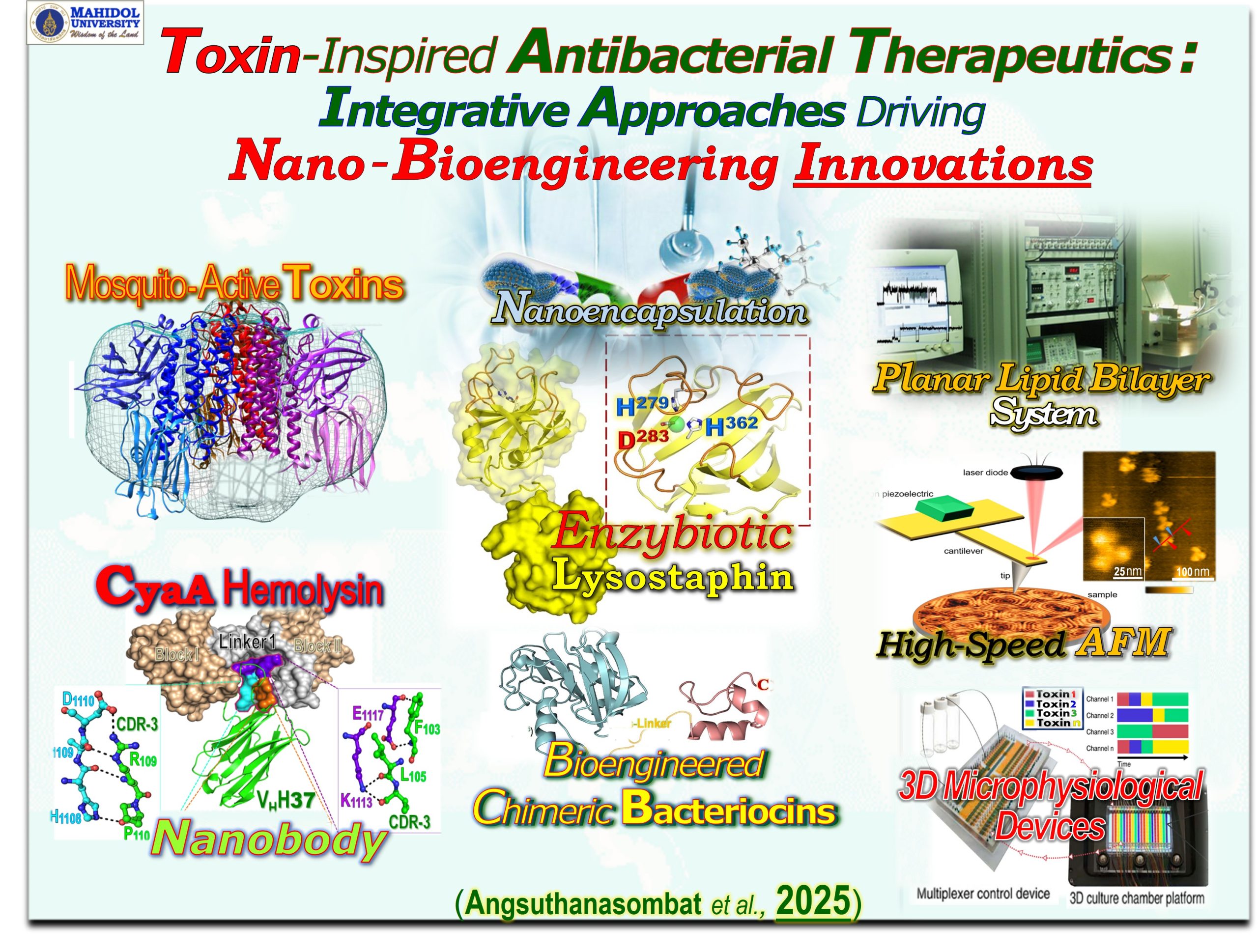From Bacterial Toxins to Therapeutics: Advancing Multidisciplinary Research towards Biomedical Engineering Innovations.
Tel: 66 (0) 2441-9003 – 7 Ext. 1237
Email: chanan.ang mahidol.ac.th
mahidol.ac.th
Ph.D. (Biochemistry), University of Cambridge, UK.
Academic Program(s)
Molecular Genetics and Genetic Engineering
Our research explores bacterial peptide and protein toxins as fundamental biological models and potential platforms for therapeutic innovations, aiming to advance infectious disease control and address antimicrobial resistance. Key targets include Cry δ-endotoxins from Bacillus thuringiensis (biopesticide), CyaA-hemolysin from Bordetella pertussis (whooping cough), TylA hemolysin and VacA cytotoxin from Helicobacter pylori (a gastric cancer risk factor), lysostaphin from Staphylococcus simulans, an effective agent against MRSA (methicillin-resistant S. aureus), and bacteriocins from probiotic bacteria.
Despite prior progress, the detailed structural mechanisms by which these toxins interact with host cells, especially in binding to specific receptors and forming membrane pores, remain insufficiently elucidated. To bridge this knowledge gap, we have applied a comprehensive, multidisciplinary approach that integrates molecular microbiology, structural biology, biochemistry, biophysics and immunology. Our investigations are enabled by advanced techniques, including protein engineering, expression in insect cells, receptor-binding assays, phage-peptide display bio-panning, structural modelling and MD simulations, high-resolution imaging, spectroscopy, and functional assays.
Looking ahead, we aim to translate these fundamental insights into therapeutic innovations. Current initiatives explore nanoencapsulation strategies for engineered toxin-based therapeutics using bio-nanocarriers (e.g., prebiotic inulin nanoparticles) to enhance stability, targeted delivery, and efficacy in the gastrointestinal environment. Concurrently, we plan to establish human-relevant 3D gastrointestinal organoid models integrated with advanced biomedical engineering platforms, including microfluidics, to more accurately simulate disease conditions and assess therapeutic responses.
Through integrative multidisciplinary approaches, this research would propel fundamental scientific understanding and translational advances. By linking molecular discoveries with biomedical engineering innovations, it would create a platform for next-generation therapeutic development with strong potential for clinical and commercial applications.

[1] Sriwimol, W., Aroonkesorn, A., Sakdee, S., Kanchanawarin, C., Uchihashi, T., Ando, T. & Angsuthanasombat, C. (2015) Potential pre-pore trimer formation by the Bacillus thuringiensis mosquito-specific toxin: Molecular insights into a critical prerequisite of membrane-bound monomers, J. Biol. Chem. 290: 20793. DOI: 10.1074/jbc.M114.627554.
[2] Malik, A., Imtong, C., Sookrung, N., Katzenmeier, G., Chaicumpa, W. & Angsuthanasombat, C. (2016) Structural characterization of humanized nanobodies with neutralizing activity against the Bordetella pertussis CyaA-hemolysin: Implications for a potential epitope of toxin-protective antigen. Toxins 8: 99. DOI: 10.3390/toxins8040099.
[3] Meetum, K., Imtong, C., Katzenmeier, G. & Angsuthanasombat, C. (2017) Acylation of the Bordetella pertussis CyaA-hemolysin: Functional implications for efficient membrane insertion and pore formation, Biochim. Biophys. ActaBiomembrane 1859: 312. DOI: 10.1016/j.bbamem.2016.12.011.
[4] Thamwiriyasati, N., Kanchanawarin, C., Imtong, C., Chen, C.J., Li, H.-C. & Angsuthanasombat, C. (2022) Complete structure elucidation of a functional form of the Bacillus thuringiensis Cry4Ba -endotoxin: Insights into toxin-induced transmembrane pore architecture, Biochem. Biophys. Res. Commun. 620: 158. DOI: 10.1016/j.bbrc.2022.06.065.
[5] Charoenjotivadhanakul, S., Imtong, C., Li, H.-C. & Angsuthanasombat, C. (2023) Conserved loop residues−Tyr270 and Asn372 near the catalytic site of the lysostaphin endopeptidase are essential for staphylolytic activity toward pentaglycine binding and catalysis, Biochem. Biophys. Res. Commun. 668: 111. DOI: 10.1016/j.bbrc.2023.05.085.
1990-1994, British Chevening Award, UK government’s global scholarship program, funded by the Foreign and Commonwealth Office (FCO);
1994, Young Scientist Award, Foundation for the Promotion of Science & Technology under the Patronage of His Majesty the King;
1995, Career Development Award, National Science & Technology Development Agency;
2001, Taguchi Prize for Outstanding Research Achievements, Thailand-Japan Collaboration, Biotechnology Society;
2002, Member Thai Academy of Science & Technology Foundation (TAST);
2010, NRCT Academy Award for Outstanding Research (Chemical & Pharmaceutical Science), National Research Council of Thailand (NRCT);
2011, Outstanding Alumni Award, Chiang Mai University Science Alumni Association;
2013; Knight Grand Cordon (Special Class) of the Most Noble Order of the Crown of Thailand (Maha Vajira Mongkut), Office of the Prime Minister;
2015, Distinguished Alumni Award for Excellence in Academic/ Research, Graduate Studies of Mahidol University Alumni Association;
2020, Knight Grand Cordon (Special Class) of the Most Exalted Order of the White Elephant (Maha Paramabhorn Chang Phueak), Office of the Prime Minister
![]()






